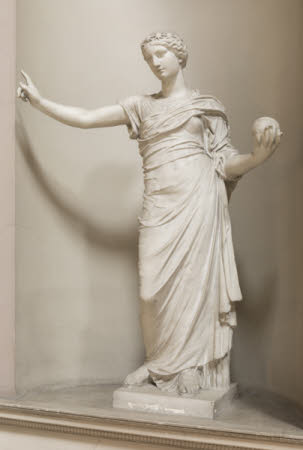Urania
workshop of Matthew Brettingham the Younger (1725 - 1803)
Category
Art / Sculpture
Date
circa 1758
Materials
Painted plaster
Measurements
1455 x 1130 mm
Place of origin
London
Order this imageCollection
Kedleston Hall, Derbyshire
NT 109008
Summary
Painted plaster, Urania, possibly cast by Bartolomeo Mattevali on behalf of Matthew Brettingham (1724-1803), cast c. 1758. A full-length plaster cast painted white of Urania, after the antique. Urania, muse of astronomy, as a young woman, draped and standing in contrapposto. In her proper left hand she holds a celestial globe, and with proper right arm outstretched she points her right index finger up to the heavens. She wears a crown of stars. Mounted on a plaster base. The cast is after an Roman statue owned by an unidentified gentleman known as 'Monsieur Berton' in Brettingham's Rome Account Book (see full description).
Full description
Nathaniel Curzon (1726-1804) acquired this cast of Urania from Matthew Brettingham (1725-1803), an architect who primarily dealt in antiquities and casts for the British aristocracy. The cast is recorded as 'Muse Urania' in a handwritten inventory of sculpture and statuary produced by Curzon himself in around 1760 (MS, Kedleston Archive). It is recorded again in a list inscribed on the verso of that inventory, under the subheading 'Saloon Statues'. The statue was initially installed in the Saloon ('Catalogue of the pictures, statues, &c. at Kedleston', 1758, Saloon, p. 9) but by c. 1788-89, when the Saloon was converted into a ballroom, Urania was moved to the Marble Hall, where she stands today (see annotated Catalogue of 1769, p.7, in the Getty Research Institute). A receipted bill dated 23 January 1758 from Brettingham shows that Curzon paid £8 for a cast of 'The Muse Urania' (MS, Kedleston Archive), which is between £800 and £900 in today's money. During his seven-year stint in Rome (1747-54) Brettingham not only dealt in casts and antiquities - furnishing the Earl of Leicester, for example, with casts and marble statues for Holkham - but also commissioned actual moulds to be taken from celebrated Roman statues. The idea was that casts could then be made to order when he returned to London. Urania was one of twelve moulds of antique statues Brettingham commissioned, at considerable trouble and expense, presumably owed to the quality of its drapery (Kenworthy-Browne 1983: pp. 100, 108-12 Appendix 2). According to Brettingham's Rome Account Book, his ledger of statues dealt, casts made, bought and sold when he was in Italy, the records for February 1754 show that a mould was taken of 'ye drapery figure of Monsr Berton', an unknown gentleman in Rome (Kenworthy-Browne 1983, p. 80). A record for April of that year also refers to a 'Mould of Monsur Bertons Antique Figure of Urania', and finally, in January 1755, the 'Muse of Mr Berton' is listed within the twelve statues 'Moulded at 10 Guineas each' which Brettingham was to take back to London (Kenworthy-Browne 1983, pp. 97, 100). Despite bringing back to London an Italian craftsman (Bartolomeo Mattevali) specifically for the job of casting from the moulds, few actually sold. There are only other surviving cast of Urania was sold in 1757-8 to the Earl of Leicester for £8. Alice Rylance-Watson March 2019
Provenance
Purchased by Nathaniel Curzon, 1st Baron Scarsdale (1726-1804), from Matthew Brettingham the Younger (1725-1803) c. 1758; identifiable in the 'Catalogue of the pictures, statues, &c. at Kedleston' of 1758 (Saloon, p. 9), of annotated 1769 Catalogue, p. 7, in Getty Research Institute, Los Angeles [annotations date to c. 1788-89, after Saloon statues were moved to the Marble Hall] and 1861 (Marble Hall, p. 7); purchased with part of the contents of Kedleston with the aid of the National Heritage Memorial Fund in 1987 when the house and park were given to the National Trust by Francis Curzon, 3rd Viscount Scarsdale (1924-2000).
Credit line
Kedleston Hall, The Scarsdale Collection (acquired with the help of the National Heritage Memorial Fund and transferred to The National Trust in 1987)
Makers and roles
workshop of Matthew Brettingham the Younger (1725 - 1803), dealer possibly Bartolomeo Mattevali, caster
References
Kenworthy-Browne 1983: John Kenworthy-Browne, 'Matthew Brettingham's Rome Account Book 1747-1754', The Volume of the Walpole Society, vol.49 (1983), pp.37-132, pp. 80, 97, 100, 132. Kenworthy-Browne 1993: John Kenworthy-Browne, ‘Designing around the statues. Matthew Brettingham’s casts at Kedleston’, Apollo, April 1993, pp.248-252






